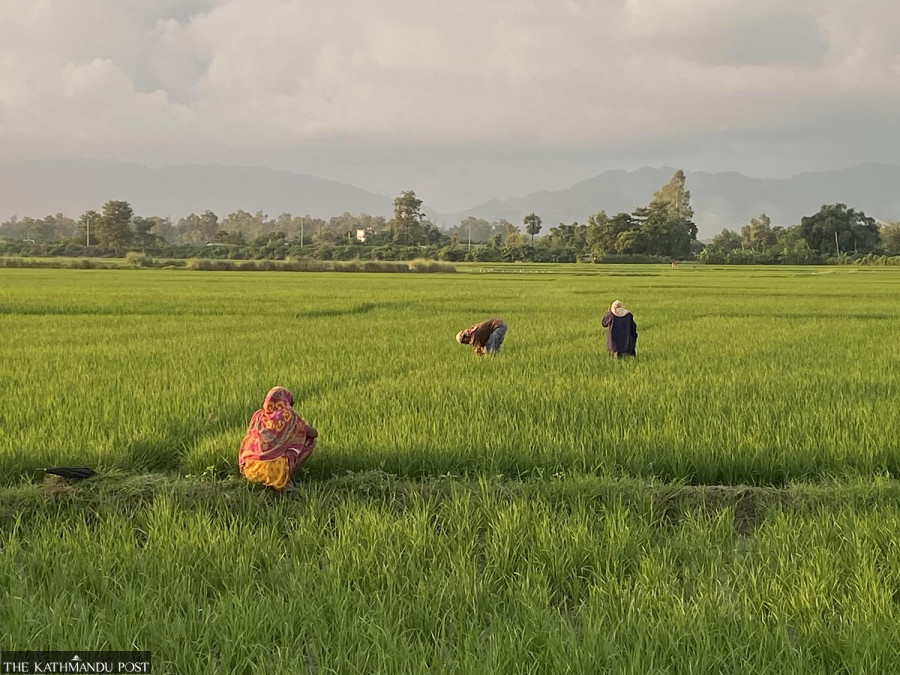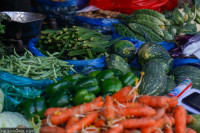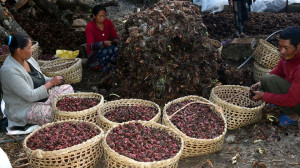Money
Paddy transplantation falls 5 percent, output may drop up to 7 percent
Madhesh was hit hardest by drought, but late monsoon rains brought partial recovery to key food-producing regions.
Post Report
Paddy transplantation has been completed on 95 percent of the 1.37 million hectares of farmland across the country, according to final data released by the Agriculture Ministry on Monday.
Experts warn that a modest drop in output could further strain an economy already weighed down by weaker productivity. Transplantation this year is down three percentage points from last year, when 98.54 percent of available fields were planted.
The ministry said transplantation was carried out on 1.3 million hectares, leaving 70,173 hectares fallow—most of it in Madhesh Province, which alone accounted for 50,518 hectares.
Based on the national average yield of 3.98 tonnes per hectare, this shortfall translates to an estimated loss of 279,288 tonnes of paddy.
“We have estimated that total output may drop 5 to 7 percent this year,” said Tilak Raj Chaulagain, an agricultural economist at the Department of Agriculture.
Although Madhesh suffered a severe rainfall deficit in June and July, heavy downpours in early August revived hopes of a significant recovery in Madhesh and Koshi, Nepal’s top food-producing regions.
Still, transplantation in Madhesh remains incomplete on 14 percent of its 370,145 hectares.
“Madhesh was badly hit by dry conditions early on, but the situation has partially recovered,” Chaulagain said.
The Madhesh province has 370,145 hectares of paddy fields spread across Saptari, Siraha, Dhanusha, Mahottari, Sarlahi, Rautahat, Bara, and Parsa districts.
Last year’s record harvest of 5.94 million tonnes was largely driven by Madhesh’s contribution after regular monsoon rains ensured one of the fastest transplantation rates in decades. This year, however, the pace slowed due to a rainfall deficit in both Madhesh and Koshi.
Large parts of Madhesh, particularly from Siraha to Mahottari, remain chronically dry because of limited irrigation. The Bagmati, Kamala, and Narayani rivers, along with the Chandra Canal, are the main water sources, but no reliable perennial system exists.
Except for the last two years, when heavy monsoon rains boosted yields, Madhesh fields have often stayed parched.
According to the Agriculture Ministry, transplantation in Madhesh stands at 86.35 percent of available fields, compared to 97 percent at the same time last year.
Other provinces fared better: Sudurpaschim (99.72 percent of 176,151 hectares), Karnali (99.34 percent of 41,042 hectares), Lumbini (98.37 percent of 302,939 hectares), Koshi (97.24 percent of 276,386 hectares), Bagmati (97.27 percent of 115,621 hectares), and Gandaki (96.63 percent of 94,182 hectares).
Monsoon rains are vital for Nepal’s Rs6.17 trillion economy. They provide nearly 80 percent of the water required for agriculture and recharge reservoirs and aquifers. With nearly half of Nepal’s farmland still lacking irrigation, the June-September rains are the single most important factor in determining crop output.
Because agriculture contributes 23.9 percent to the GDP and employs more than 60 percent of the population, the performance of the monsoon directly influences consumer spending, food inflation, and even government revenue. Above-normal rainfall usually boosts yields, helping to keep rice prices stable, reduce imports, and ease pressure on household budgets.
This year, Nepal saw regular and heavy pre-monsoon showers, and the monsoon arrived early on May 29—two weeks ahead of schedule. Yet, large parts of Madhesh remained dry for more than six weeks, creating an unexpected drought despite forecasts of above-average rainfall. Water sources dried up, groundwater levels fell, and both drinking and irrigation water grew scarce.
On July 23, the federal government declared all 136 municipalities of Madhesh drought-affected. Days later, Prime Minister KP Sharma Oli conducted an aerial survey of the parched region, where farmlands had cracked and residents were queuing for water.
Research shows that cultivated area, fertiliser use, and mechanisation are the strongest drivers of crop yield. Experts argue that instead of pouring billions into scattered subsidies, the government should redirect resources toward modernising agriculture—providing timely fertilisers, subsidising machinery, and supporting commercial farming practices.
They also suggest establishing more bank branches in farming regions to expand access to finance and encourage farmers to invest in productivity-enhancing technologies.




 6.1°C Kathmandu
6.1°C Kathmandu














